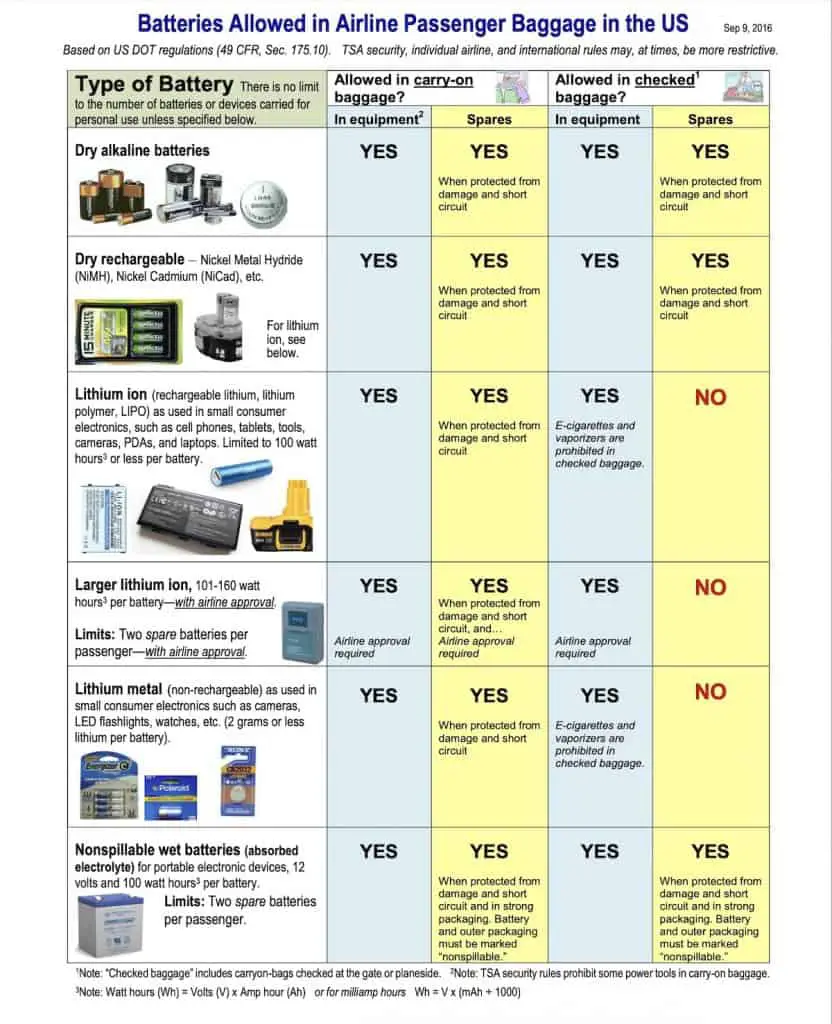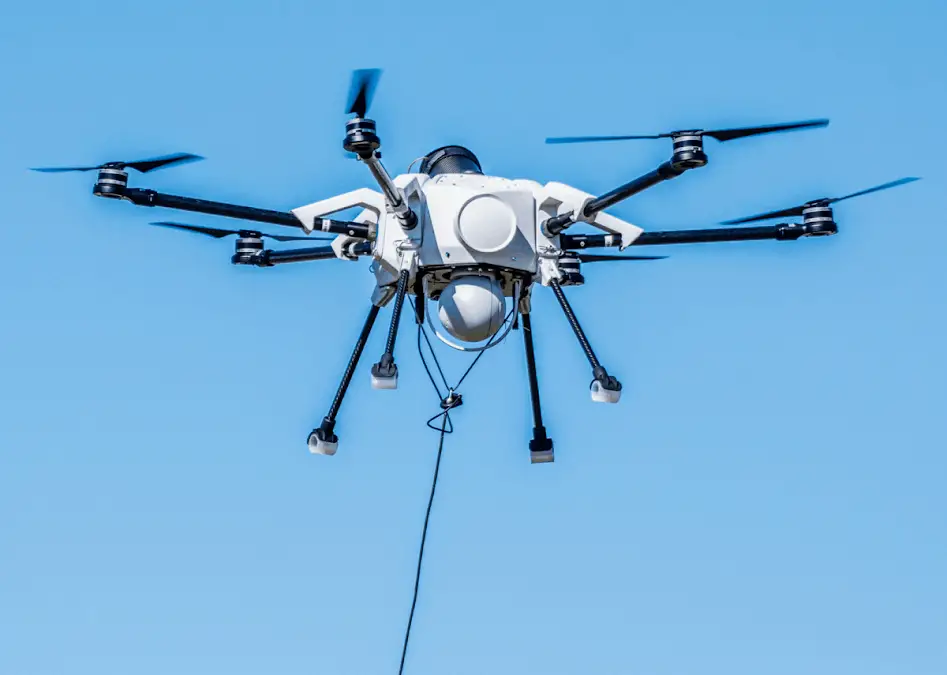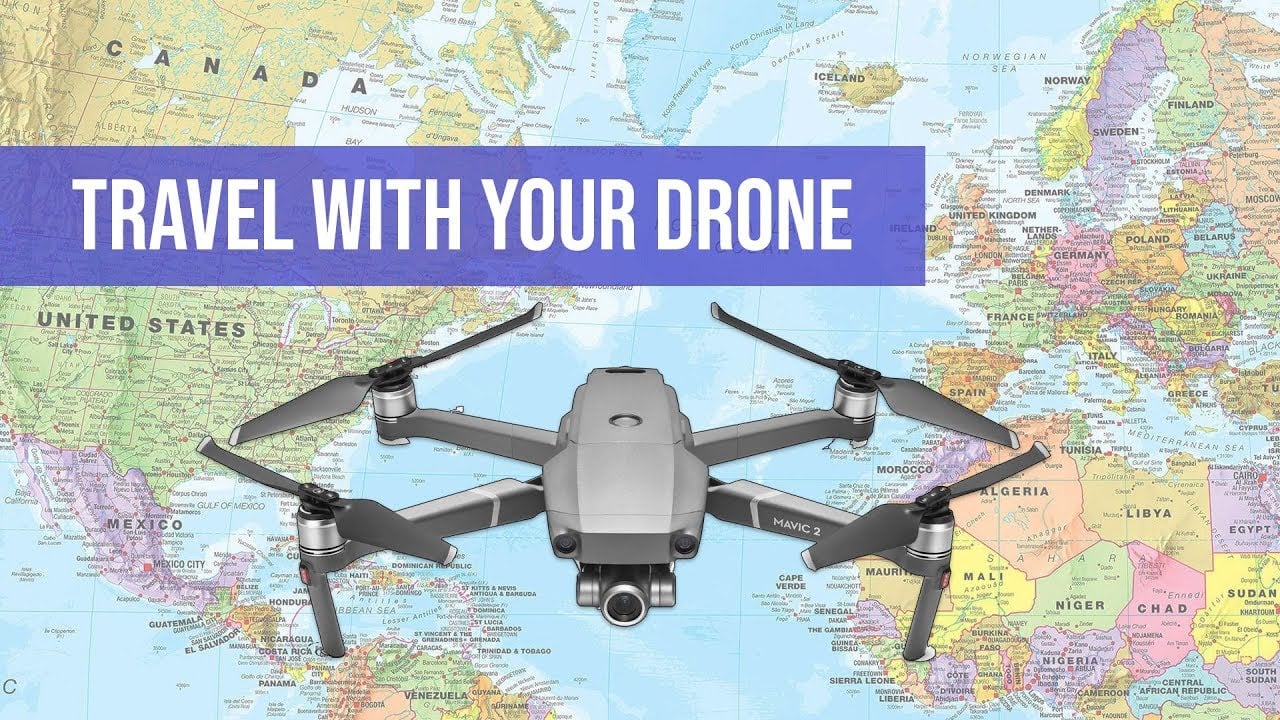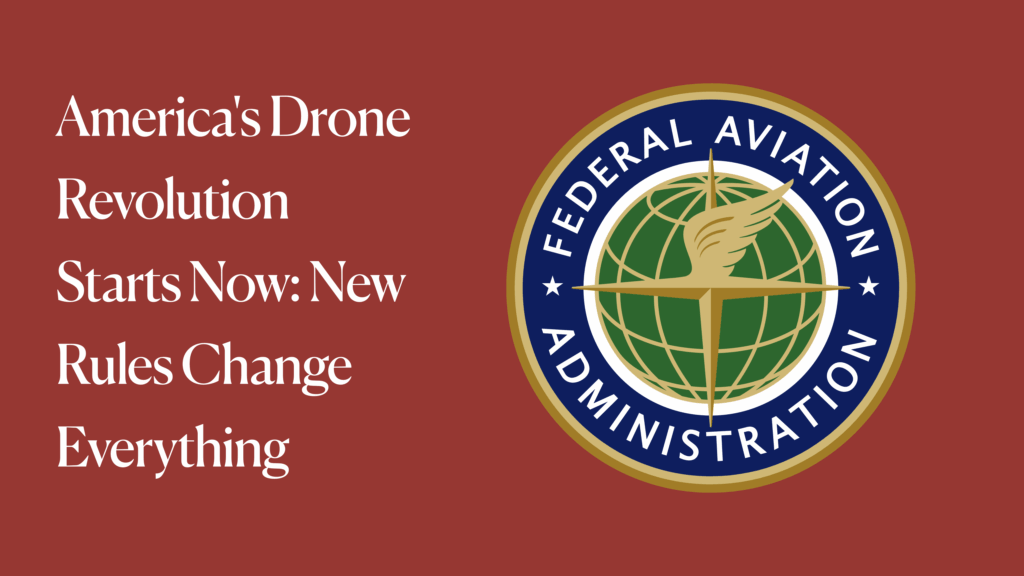Drone owners love using unmanned aerial vehicles (UAV) for drone photography and aerial videography. It should be no surprise that they want to take their drone with them on their travels.
However, not every airline or travel destination is drone-friendly. And not every drone is travel-friendly.
So, before you pack that travel drone, we encourage you to:
- First, consider whether it will comply with your country’s airline or airport security requirements. The Transportation Security Administration (TSA) is responsible for airport security in the USA.
- Check if you will comply with any regulations regarding hazardous material transport (batteries are typically covered here).
- Find and review your specific airline policies regarding the transport of drones, and
- Ensure you are familiar with drone laws in your departure and arrival locations.
Whether you will be the drone pilot or supporting drone operator, we encourage you to start by understanding the drone regulations in your departure and destination locations. You should check which permits, import licenses, or registrations are required and get the necessary documentation or approvals before your departure. We have identified the regulators and applicable drone laws for all the major country destinations on this website. Start by reviewing those pages.
We assume that you have experience flying drones, are appropriately licensed in your departure location, know the basics of operating an unmanned aircraft safely, are familiar with identifying controlled airspace and rules governing drone flight and clearances when required.
This page will show you how to transport your travel drone on a plane legally. In addition, you’ll learn how to pack your drone and drone battery for air travel. We’ll also help you identify when to check with your specific airline for additional information.
These tips may vary slightly from country to country, depending on specific variations from TSA and FAA guidelines. In other words, these tips were written from the perspective of a traveler from the USA. However, if you are in another country, say the United Kingdom, and traveling internationally, say to Brazil, you will need to review the Drone Laws in the United Kingdom and the Drone laws in Brazil to tailor the general rules of thumb here.
We encourage contacting your airline customer service and regulators in your departure country and destination.
How can you bring a drone on an airplane?
Follow these steps when packing a drone in your carry-on or checked baggage:
- Check that the drone is turned off and that any switches are not accidentally activated.
- Consider purchasing a specialized drone carrying case to protect your drone from damage.
- If you are traveling with a smaller drone or a foldable drone, you may have the option to take your drone in carry-on luggage or hand luggage. Your options for a larger drone may be limited to checked luggage or a special freight shipment. You should check with your airline to see if you should pack your drone as carry-on or checked baggage.
Due to the USA Department of Transport (DOT) ban on transporting lithium-ion batteries in passenger plane cargo compartments, some airlines require drones to be packed only in carry-on baggage (stored in an overhead compartment or other nearby storage).
Drone batteries on an airplane
Because Lithium-ion/polymer (LIPO) batteries power most drones, you must adhere to all applicable FAA hazardous materials regulations. Therefore, batteries for LIPO devices should be kept in your carry-on luggage. Although you may be able to pack lithium-ion batteries in your checked baggage in certain circumstances, we have found that the rules for traveling with a spare lithium battery in carry-on baggage are more straightforward to follow.
Please note that some airlines may have a different drone policy for transporting a drone with the battery installed versus a spare battery.
Stay below the airline’s Watt-Hour limit
For LIPO batteries, you’ll need to know how many watt-hours (Wh) your battery has before you can pack them in your carry-on luggage:
It is essential to check the Wh of your specific batteries. Most small consumer drone batteries have less than 100 Wh of capacity, which is generally accepted on most flights. However, yours may be different and exceed the specific airline restrictions.
See the example at the bottom of the page to calculate the watt-hours of your battery.
This information is typically supplied with the battery on a purchase or found in your battery supplier specifications publication.
You can find additional information on flying with batteries and transportation of restricted items using the following resources:
LIPO Batteries in carry-on luggage
Follow these steps when packing LIPO batteries with 100 Wh or less in your carry-on luggage:
- To keep LIPO batteries from short-circuiting in your carry-on luggage, use one of the following methods:
- Leave the batteries in their original packaging,
- Tape the battery terminals,
- Use a battery case,
- Use a battery sleeve in a camera bag, or
- Place them snugly in a plastic bag or protective pouch.
- Your batteries must be for personal use only (including professional use). Do not pack batteries for resale or vendor distribution.
- Check with your airline to see if there are any restrictions on bringing LIPO batteries onboard in your carry-on bag.
Follow these procedures when packing LIPO batteries with more than 100 Wh but less than 160 Wh in your carry-on baggage:
- You must obtain airline approval to bring a larger LIPO battery (more than 100 Wh) onboard in your carry-on baggage.
- Pack no more than two spare batteries with a capacity of more than 100 Wh.
- Keep batteries in their original packaging, a battery case, or a separate pouch or pocket to avoid a short circuit.
LIPO Batteries in Checked Baggage
You must obtain airline approval to bring a larger LIPO battery (more than 100 Wh) onboard in your carry-on baggage.
Do not carry more than two spare batteries with a capacity of more than 100 Wh.
Keep batteries in their original packaging, a battery case, or a separate pouch or pocket to avoid a short circuit.
Typical portable DJI drone and battery ratings:
Note that these drones all carry batteries below a 100 Wh specification and can typically be carried on without limitations. However, please note that the DJI Inspire 1 battery is rated at 129.96Wh, covered in the 100 wH to 160 wH rules, requiring special permission and limited to two spares.
DJI Inspire 2 – 4280 mAh and 97.58 Wh
DJI Mavic Air – 2375 mAh and 27.43 Wh
DJI Mavic Mini – 1100 mAh and 8.36 Wh
DJI Mini 2 – 2250 mAh and 17.32 Wh
DJI Phantom 3 – 68 Wh
DJI Phantom 4 – 5870 mAh and 89.2 Wh
DJI Mavic Pro – 2250 mAh and 43.6 Wh
DJI Spark – 1180 mAh and 16.87 Wh
If you use rechargeable lithium-ion batteries that are not original DJI OEM batteries, these may have different energy specifications than those listed above.
For more information on battery guidelines, please see the section at the bottom of this page.
Dealing with Customs processes for your drone
Before traveling, we encourage US travelers to register their drone with Customs as a “Personal Effect Taken Abroad.” This registration will prevent confusion about whether you are returning with the same drone you left with or importing a new drone purchased elsewhere.
Drone regulations are found on this site for most countries throughout the world. Go to the respective page for the drone laws governing your departure and arrival countries when traveling internationally.
You may wish to check for regulations in countries that you are connecting through to ensure that your drone is not confiscated.
Check for any drone laws that apply to foreigners. We have attempted to collect as many of these as are published.
Some countries require foreigners to obtain special permission to fly drones, which their citizens do not need. In some cases, countries outright prohibit foreigners from bringing drones through customs.
When traveling with a drone, we encourage you to declare your drone (in a carry-on or a checked bag) with the appropriate customs officials.
FAA Battery Guidelines
For your information, we reproduce the FAA guidelines for batteries carried by airline passengers:

What batteries does the FAA allow in carry-on baggage (in the aircraft cabin)?
For carry-on baggage checked at the gate or planeside, see below. Passengers can carry most consumer-type batteries and portable battery-powered electronic devices for personal use in carry-on baggage. Spare batteries must be protected from damage and short circuit. Battery-powered devices must be protected from accidental activation and heat generation. Damaged or recalled batteries, including when in a device, must not be carried. Batteries allowed in carry-on baggage include:
Dry cell alkaline batteries: typical AA, AAA, C, D, 9-volt, button-sized cells, etc.
Dry cell rechargeable batteries like Nickel Metal Hydride (NiMH) and Nickel Cadmium (NiCad).
Lithium-ion batteries (a.k.a.: rechargeable lithium, lithium polymer, LIPO, secondary lithium). Passengers may carry all consumer-sized lithium-ion batteries (up to 100 watt-hours per battery). This size covers AA, AAA, cell phone, PDA, camera, camcorder, handheld game, tablet, portable drill, and standard laptop computer batteries. The watt-hours (Wh) rating is marked on newer lithium-ion batteries and is explained below. External chargers are also considered to be a battery.
With airline approval, devices can contain larger lithium-ion batteries (101-160 watt-hours per battery), but spares of this size are limited to two batteries in carry-on baggage only. This size covers the largest aftermarket extended-life laptop batteries and most lithium-ion batteries for professional-grade audio/visual equipment.
Lithium metal batteries (a.k.a.: non-rechargeable lithium, primary lithium). These batteries are often used with cameras and other small personal electronics. Consumer-sized batteries (up to 2 grams of lithium per battery) may be carried. This includes all the typical non-rechargeable lithium batteries used in cameras (AA, AAA, 123, CR123A, CR1, CR2, CRV3, CR22, 2CR5, etc.) and the flat round lithium button cells.
Non-spillable wet batteries (absorbed electrolyte), limited to 12 volts and 100 watt-hours per battery. These batteries must be the absorbed electrolyte type (gel cells, AGM, etc.) that meets the requirements of 49 CFR 173.159a(d); i.e., no electrolyte will flow from a cracked battery case. Batteries must be in strong outer packaging or installed in equipment. Passengers are also limited to two (2) spare (uninstalled) batteries. Spare batteries’ terminals must be protected (non-conductive caps, tape, etc.) within the outer packaging. The batteries and outer packaging must be marked “non-spillable” or “non-spillable battery.” Note: This exception is for portable electronic devices, not vehicle batteries.
What kinds of batteries does the FAA allow in checked baggage (including gate-checked bags)?
Except for spare (uninstalled) lithium metal and lithium-ion batteries, all the batteries allowed in carry-on baggage are also allowed in checked baggage. The batteries must be protected from damage and short circuit or installed in a device. Battery-powered devices-particularly those with moving parts or those that could heat up-must be protected from accidental activation. Spare lithium metal and lithium-ion/polymer batteries are prohibited in checked baggage; this includes external battery packs. Electronic cigarettes and vaporizers are also prohibited in checked baggage. “Checked baggage” includes bags checked at the gate or planeside.
How do I determine the watt-hours (Wh) rating of a battery?
To determine watt-hours (Wh), multiply the volts (V) by the ampere-hours (Ah). Example: A 12-volt battery rated to 8 Amp-hours is rated at 96 watt-hours (12 x 8 = 96). For milliamp-hours (mAh), divide by 1000 (to get to Ah) and then multiply by the volts.
Is there a limit to the number of batteries or devices I can carry?
The main limit is that the batteries and devices must be for personal use (including professional use). Batteries and battery-powered devices carried for resale or for distribution by a vendor do not qualify for these exceptions. There is a two-spare limit on the large lithium-ion (101-160 Wh) and non-spillable batteries.
What does “protected from short circuit” mean?
When metal objects such as keys, coins, tools, or other batteries come in contact with both battery terminals, it can create a “circuit” or path for electricity to flow through. Electrical current flowing through this unprotected short circuit can cause extreme heat and sparks and even start a fire. Keep spare batteries in their original packaging, a battery case, or a separate pouch or pocket to prevent short circuits. Make sure loose batteries can’t move around. Placing tape over unpackaged batteries’ terminals also helps insulate them from short circuits.
Can you take a drone on an international flight?
Yes. Small drones are generally allowed on international flights. However, you should check with your airline before traveling for their specific policy. Drones containing lithium batteries, fuel cells, and components of certain parachute systems may be prohibited in baggage.
Can you take a drone on a plane?
Yes, you can bring a drone on a plane. According to the FAA regulations, you can either pack the drone in your checked luggage or carry it on the plane (with your carry-on luggage) with you. However, there are a few rules to follow (see above). It is important to check with the specific airline and airport security requirements before traveling with a drone, as rules may vary depending on the airline and country.
What are the TSA Battery Rules 2023?
The TSA battery rules for drones in 2023 are:
If a lithium-ion drone battery does not exceed 100Wh, it may be carried on the airplane or checked in a bag.
If the lithium-ion drone battery exceeds 100Wh but does not exceed 160 Wh, it must be carried on, AND airline approval is required, AND you can only bring two and not three batteries.
If the battery exceeds 160 Wh, it may not be carried on or checked.
SPARE lithium-ion batteries (including lithium polymer) are PROHIBITED in checked baggage. However, a drone battery is allowed in checked baggage if installed in the drone.
All drone batteries in checked or carry-on luggage must be protected against puncture and short circuit.
You can bring a maximum of three drone batteries in your carry-on luggage: one in the drone and two spares.
All spare (uninstalled) batteries may ONLY be taken in your CARRY-ON baggage. It is PROHIBITED to pack spare lithium batteries in your checked luggage.
Drones containing lithium batteries may be prohibited in baggage.
Please note the TSA Drone Policy may change occasionally. We recommend you check the tea websites listed above for the latest information.
Here is a good video covering tips for traveling with a drone:
NOTE: This page is about the Regulation of Unmanned Aerial Vehicles: Small Unmanned Aerial Systems (SUAS), Small UAS, Remote Piloted Aerial Systems (RPAS), unmanned aerial vehicle (UAV), Unmanned Aerial System (UAS), and drone are interchangeable terms unless specified. Model Aircraft, toy, remote-controlled, and RC aircraft may be covered by the same regulations unless specified.
Find out why
We think you must use a Drone Preflight Checklist
And a Drone Post-flight checklist
Free Drone Flight Checklist PDF
This Drone Flight Checklist is better than others.
It’s free!
It includes both the preflight checklist and post-flight checklist
It’s an easy-to-use printable PDF that covers all your bases.
Traveling with a Drone?
Click here to read our Comprehensive Guide For Traveling With A Drone.




